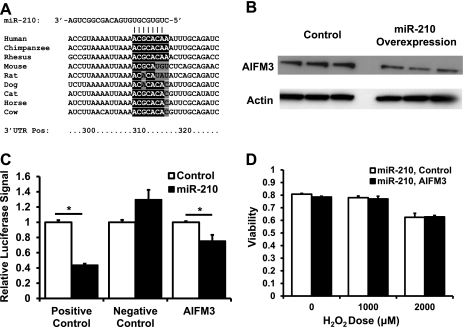Fig. 5.
Apoptosis-inducing factor, mitochondrion-associated 3 (AIFM3) is targeted by miR-210 but does not mediate the cytoprotective effects of miR-210. A: alignment of the 3′-untranslated region (UTR) of AIFM3 from various species with the seed sequence of miR-210. Human AIFM3 is targeted by miR-210 but mouse and rat AIFM3 are not. Bases highlighted in black are seed sequence matches according to TargetScan S. Bases highlighted in gray are seed sequence mismatches. Note that, for the purposes of microRNA targeting, an adenine on the mRNA aligning with the first base pair of a microRNA is considered a seed match. Nos. along the bottom denote the base position along the 3′-UTR in human AIFM3. B: Western blot of HEK293 cells infected with miR-210 adenovirus vs. control adenovirus and probed with AIFM3 antibody. miR-210 overexpression reduces AIFM3 expression. C: luciferase assay with AIFM3 3′-UTR cloned into the 3′-position of the luciferase reporter gene demonstrates that plasmid-mediated miR-210 overexpression reduces luciferase activity, indicating that AIFM3 is a target of miR-210 (*P < 0.05). Positive control is a luciferase construct in which two perfect matches to the miR-210 sequence were cloned into the 3′-position of the luciferase reporter gene. Negative control is a luciferase construct in which nothing was cloned into the 3′-position of the luciferase reporter gene. D: AIFM3 overexpression in the presence of miR-210 overexpression does not reduce cellular viability either at baseline or in the presence of hydrogen peroxide. Data are presented as means ± SE; n ≥ 3 in each group.

